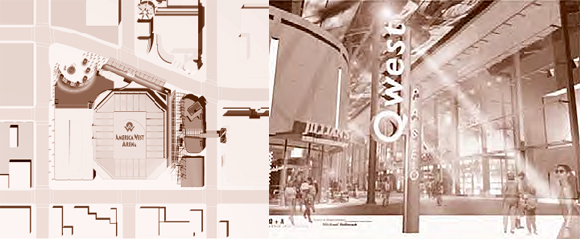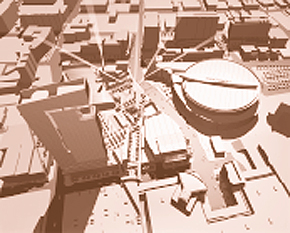
Few building types have had a greater impact on our communities than the modern sports facility. They affect local transportation, public funding priorities, urban planning, and city and state politics. Their power to influence public policy, public open space, city skylines, and even a region’s international public relations has resulted in an inevitable love-hate relationship with these projects.
The public interest in these projects was vividly demonstrated to me in January of 1996. I was a principal with NBBJ architects, interviewing for the design of a new retracting-roof ballpark for the Seattle Mariners in Downtown Seattle. Now known as Safeco Field, the project was controversial, as many of these developments are. There was nothing surprising in that fact, but when the selection committee chose us over our rivals at HOK, the Seattle Times ran the selection as a banner headline. Not just a front-page story, but an inch-tall headline. It was dramatic evidence that these facilities had become the rock stars of architecture. They were no longer design problems for a few specialty sports architects; they were an opportunity to alter a city’s perception of itself, which is always a newsworthy event.
Today, professional sport is simply a subset of the much larger marketplace of entertainment. Its health and survival in our society will depend on adapting to changing consumer markets. Entertainment retail and sports are essentially a marriage made in marketing heaven. Typical arenas in the U.S. can regularly attract 2 million visitors a year without much regard to the location. That drawing power is valuable to many other interests including retail, dining, and corporate advertisers willing to invest in a product that goes beyond the traditional sponsor signage found in most facilities today. The drawing power of sports and entertainment facilities can also help to re-energize the public realm of our city centers.
Changing Concepts of the Sports Facility
What might be required from these facilities in the future is best understood in the context of their historical evolution. The modern day sports facility, like most other naturally evolving things in our society, saw significant changes only when there were outside forces at work. After the rise of sports venues under Greek and Roman cultural domination, new facility development virtually stopped for more than a millennium. It took several unrelated events—the industrial revolution that created a middle class with leisure pursuit interests, the invention of several new forms of team sports, and the creation of the modern era Olympic movement—to bring renewed interest in arena and stadium development.
The early 19th century fostered a climate of development that resulted in some of the most venerated of sports facilities, including Fenway Park, Wrigley Field, and Forbes Field. Unfortunately, the contribution these projects made to the language of sports design was lost to later generations of planners, who abandoned the urban centers of American cities in favor of post World War II suburbia. By the ‘60s, downtowns were suffering from compound social and economic ills. The undeveloped areas outside central cities offered affordable real estate, room for parking cars that Americans now loved to drive, and new freeways to take them there. The stadium archetypes that resulted from the new and simplified planning models cleverly accommodated a range of sporting events, but they were Spartan, devoid of any of the personality that endeared so many fans to the older venues.
Fortunately, the suburban myopia that affected everything from housing development to retail malls and transportation was about to experience another paradigm shift. Supported by urban redevelopment efforts, stadiums and arenas would no longer be seen as isolated objects. These projects, capable of attracting millions of visits yearly, could serve as economic engines for urban centers.
While there was significant construction of facilities during the ‘60s and ‘70s, the true renaissance did not begin until the ‘80s. This time around, many new and powerful forces were in play. Unabashedly aggressive cities courting team relocations, player celebrity with its accompanying stratospheric salaries, escalating corporate sponsorships, and cable television all fueled development. There was also a subtle but growing shift toward a new entertainment economy.
Under the unwritten rules of the new entertainment economy, a trip to the stadium or arena must be an entertaining experience before, during, and after the game, win or lose. Otherwise, fans will simply opt out to find new forms of leisure-time amusement. And, when attendance at live sports events loses its cachet for the general public, there will be less reason for corporations to support teams or facilities by owning exclusive seating. Going to the game must be a universally appreciated experience, or the entire complex of interconnecting needs begins to unravel.
Sports, of course, is not the only industry to go through such rapid transformational change. Retail has shifted just as radically, and the surviving product is also a much more entertaining and interactive experience. Experiments from the ‘90s, such as City Walk at Universal City, California, and the Third Street Promenade in Santa Monica, offer divergent but equally effective views of the future of retail. Corporate retailers like Rouse and the Mills Corporation likewise have different approaches, but they share a common understanding of the need to create an experience that entertains while creating commerce.
The next generation of sports facility development will be primarily urban in location and diversified in its uses. It will more fully capitalize on the variety of ancillary uses and on the destination drawing power of the sports venue as its anchor. It will partner with other destination attractions. New, entertaining retail such as sports merchandising, music, book sales, and a greater variety of one-of-a-kind sports bars and food venues will work more closely in a partnership with the principal sports tenant.
Sports Facility Development and the Public Realm
More team owners and facility operators are now seeing the impact their projects can have on surrounding districts and are taking steps to exploit the full potential of these developments for their own programs. Two existing arena projects, Staples Center in Los Angeles and the America West Arena in Phoenix, illustrate the importance of co-developing the adjacent public district along with the facility itself.

Staples Center Arena is a prime example of a sports venue that is being used as an entertainment anchor in a larger vision. Along with a variety of concerts, conventions, and awards programs, It has the distinction of being the only arena in the world with three major franchises (two NBA and one NHL tenant). But it is not the number of event days that will ultimately allow Staples Center to endure over the next decade; it will be the successful development of its entertainment master plan.
With the arena itself complete and entering its third season, the Los Angeles Arena Land Co. is turning its attention to the creation of an entire entertainment district in downtown Los Angeles. In a site that many thought not workable for such a development, Staples Center is set to convincingly illustrate, once again, that destination attractions like stadia and arenas belong in urban cores.
The key elements in the L.A. master plan now include a convention hotel, a 7000-seat performance theater, restaurants, clubs, retail, and a public plaza that will allow for the assembly of 50,000 people outdoors. These interconnecting uses have the potential to create a much-needed sense of place for downtown LA, all of it brought about by the initial project of a single sports venue.
Some older arenas are also being newly integrated into a larger public realm. One of the pioneers of modern revenue-producing arena design, Phoenix’s America West Arena, was once the highest producing arena for advertising revenue in the NBA. That was in 1992. But that record was short-lived, ending when Chicago’s United Center opened the following year. It continued to be broken by successive facilities. Now the 17th oldest facility in the NBA, America West Arena needed a major reconstruction and is currently undergoing a $40 million redevelopment.
The New America West Arena will include two new food venues, one by Chicago based Levy, a new Jillian’s that will feature a sports bar, bowling, billiards, and after hours live music, and a complete overhaul of the public areas. Experiential Sponsorship will make its debut here in the form of a new interior entrance pavilion and an exterior public walk called the Paseo. Like the connecting walks in both Atlanta’s Philips Arena (Hawk Walk) and Miami’s American Airlines Arena, the Paseo will insure that this sports venue ends its urban introversion and becomes, out of practical necessity, a connective catalyst to other downtown experiences.
Bringing it Home
The stadia and arenas of the future will no longer be isolated affairs. Their developers will create partnerships with many non-sports industries that share the need to capture consumer attention. They will become more complex in order to become more interesting, with more diverse uses in order to generate more diverse revenues. And they will reconnect with, rather than separate themselves from, the surrounding public realm.
The planning models that are now being developed at the professional sports level will eventually be incorporated into smaller, second tier cities and universities. Like the concept of suites, which began in the most exotic of large facilities, those ideas that find a responsive consumer will be realized at many different levels and sizes of facilities. Mixed-use sports and entertainment is one of these ideas.
Our common desire to be entertained, and the corollary need to create places in which to be entertained, is one of the enduring traits of civilization. The modern-day challenge is not in developing the idealized project that can outlast all others, but in creating facilities that adapt to the best ideas of the present day without foreclosing on future possibilities.
Author Michael Hallmark is a sports and entertainment development consultant based in Los Angeles, California. He was a founding principal in two architectural practices specializing in sports facility design and was the principal architect on both the America West Arena and Staples Center Arena, among others. He is currently developing a live performance theater in Phoenix, Arizona, and arena master plans and facility improvements for the Bradley Center and for America West Arena.
Originally published 3rd quarter 2001, in arcCA 01.3, “Publicness.”





